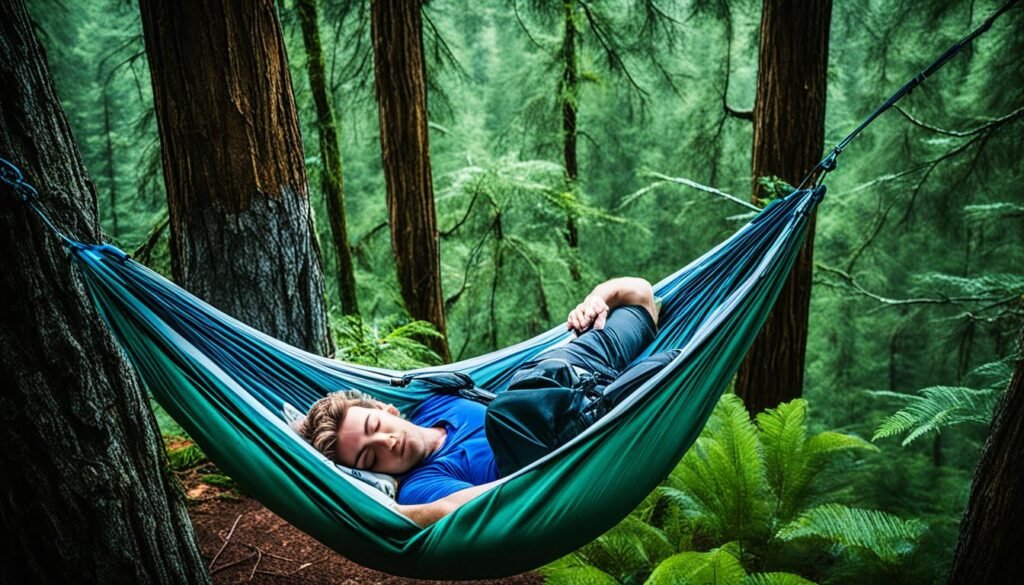Hammock camping is a fun outdoor activity and a way to sleep well. Yet, bugs can be annoying and disrupt sleep. Campers often ask if they need a bug net. Knowing about bug bite dangers and the different bug nets available is important.
In hammock camping, keeping bugs away is key. Some campers might not mind mosquito bites or bugs. But, others might have bad allergic reactions. They could find it hard to sleep with bugs around. A bug net acts as a barrier against insects. It helps campers sleep without bug interruptions.
Sleeping outside should be nice, not filled with bug bites. Getting a bug net is smart, especially in bug-heavy areas.
Key Takeaways:
- Using a bug net for hammock camping provides protection from insects and prevents bug bites.
- Bug nets come in various types and designs, offering different levels of protection.
- Bug nets allow for improved airflow while keeping insects out.
- A bug net helps campers feel less exposed and more secure while sleeping in a hammock.
- Investing in a bug net is essential for a comfortable and enjoyable hammock camping experience.
The Sad Truth about Typical Hammock and Tarp Setups
Many people using hammocks and tarps know the struggle. They look great but often fail against rain and bugs. This makes camping less fun and more risky.
Heavy rain is a big problem with tarps. Water seeps in at the open ends. Campers end up wet, which could lead to getting cold or sick.
Also, these setups don’t keep bugs away well. Bugs can bite through the too-close nets. This means campers can end up itchy and unable to sleep.
To fix this, it’s a good idea to get a better bug net. These nets fit hammocks better, keeping bugs out.
Good bug nets mean no mosquito bites. They let campers rest without bug worries. This makes sleeping outdoors peaceful.
Bug nets are key for a bug-free trip. They work great in summer or woods. Campers can sleep without bug bites.
So, upgrade if you’re tired of rain and bugs. A good bug net makes all the difference. It helps you enjoy your time outside.

Comparison of Typical Hammock and Tarp Setups vs. Hammock Bug Nets
| Typical Hammock and Tarp Setups | Hammock Bug Nets | |
|---|---|---|
| Protection from Rain | Inadequate protection from water seepage | Offers reliable protection from rain |
| Protection from Bugs | Insects can bite through the netting | Provides effective barrier against bugs |
| Comfort | Potential discomfort from wet sleeping area | Ensures a dry and comfortable sleeping environment |
| Convenience | May require additional setup and adjustments | Easy to set up and use |
Benefits of Using a Bug Net for Hammock Camping
Using a hammock bug net makes camping comfy and free from bugs. It keeps away flying bugs, spiders, bees, and more. This helps you sleep without the worry of bites.
With a bug net, you also keep cool in hot weather. The mesh lets air in but keeps bugs out. You can sleep well and stay comfortable all night.
Bug nets make you feel safer, too. They act like a shield in nature. You feel less exposed and can relax more. This lets you enjoy the outdoors even more.
FAQ
Do I really need a bug net when hammock camping?
Definitely. A bug net keeps you safe from insect bites. It lets you sleep well outside.
What are the potential dangers of bug bites while hammock camping?
Bug bites can make you itchy, cause allergies, or even need a doctor. Stay safe.
What types of bug nets are available for hammock camping?
You can find many kinds of bug nets. Some wrap the whole hammock, others just cover it.
Can bug nets keep out flying insects and other creepy-crawlers?
Yes, they stop flying bugs and crawlies like spiders and bees. You’ll rest better.
What are the benefits of using a bug net for hammock camping?
A bug net keeps bites away and lets air flow. It makes sleeping outside feel safer.







